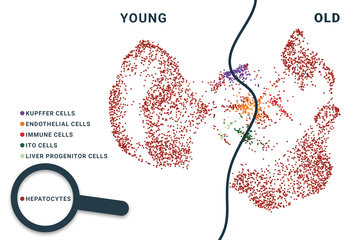Women in East Germany will be more likely to die from smoking than those in West Germany
Max Planck researcher criticizes insufficient anti-smoking policies
Due to a silent but dramatic increase in the number of young East German women smoking after reunification, their death rates are forecasted to exceed those in the West within the next few decades according to forecasts up to the year 2036 by scientists from the Max Planck Institute for Demographic Research (MPIDR) in Rostock. The deadly trend is hidden beneath a currently favourable trend in life expectancy.

The researchers found that East German women are running the risk of an unforeseen increase in deaths through smoking. According to the calculations, rates for deaths from lung cancer, which is a very strong indicator for the effect of smoking, will rise continuously for East German women aged 50 and older.
“In addition, all other smoking-related diseases will go up, such as atherosclerosis, angina, and heart attack,” says Mikko Myrskylä, director at the Max Planck Institute for Democraphic Research.
At the same time, the researchers forecast a lasting decrease in rates of lung cancer deaths and of all deaths caused by smoking for women from West Germany, as they smoke less and less.
Currently, mortality (i.e. the risk of dying from any cause) at ages 50-69 is lower among East German women than among West German women. However, in 20 years (2036) mortality in the East is forecasted to exceed mortality in the West by almost ten percent due to smoking. This excess of ten percent solely accounts for 800 deaths per year among women aged 50-69 due to smoking
“Policies are allowing this increase of deaths in East Germany to occur”, says Mikko Myrskylä. He believes that more aggressive anti-smoking policies could at least moderate the growing tobacco consumption among women in the East, which would save lives.
“Germany is more tolerant than other EU member states in its smoking policies. For example, it is the only country that allows public billboard advertising.” Smoking is also socially accepted much more widely in Germany than in other EU member states, says the demographer.
Fatal trend hidden beneath life expectancy improvements
“East Germany is about to become a cautionary tale of the consequences of insufficient anti-smoking policies and the ignorance of changing behavioural norms”, says Max Planck researcher Mikko Myrskylä.
Myrskylä fears that the worsening of smoking habits in the East might go unnoticed and not encourage prevention, because its effects cannot yet be seen in mortality data or life expectancy. The current trend in life expectancy rather seems to be a success story for women in the East.
While mortality had been much higher in the former GDR than in West Germany, the gap narrowed rapidly after German reunification, and the low life expectancy in the East rose quickly and caught up with higher values in the West.
The convergence was particularly strong for women. Today, Eastern women aged 50-69 have a lower mortality than women in the West. But this will reverse during the coming years due to smoking, according to the new MPIDR calculations.
“It takes 15 to 25 years before increased smoking shows up in mortality,“ says Mikko Myrskylä. “We need to take action now to avoid unnecessary deaths in the future.“
East-West crossover in smoking intensity and death rates
The projections are based on forecasted ‘smoking intensity’ which was computed using data from the research survey ‘Socioeconomic Panel’ (SOEP). Researchers calculated ‘smoking intensity’ as the total sum of years smoked by the age of 40.
The effects of changing smoking behaviour are most pronounced for women aged 50 to 54 and show up markedly in death rates through lung cancer (see graphic on last page). For this age group female lung cancer death rates in the West have just reached a maximum of 32 deaths per 100,000 women while values for the East are much lower (26 deaths).
For these women, who were in their teens in between 1980 and 1984, the mean smoking intensity was still high in the West (10.6 years) but low in the East (8.8 years).
Right after reunification the tide turned. Smoking intensity for women in their teens from 1990 to 1994 is projected to climb up to 9.6 years for the East and surpass the Western value, which falls to 9.3 years. Accordingly, when these women are between 50 and 54 in 2026, lung cancer death rates in the East will have surpassed those in the West (29 and 28 deaths per 100,000 women).
The situation will have reversed completely by 2036, when lung cancer death rates of women between 50 and 54 will have fallen to a low of only 21 in the West but climbed up to 31 in the East.
Those women were teenagers around 2000-2004, when projections of smoking intensity indicate a 40-year-low of only seven years in the West but an increase up to a historical maximum of 10.6 years in the East.
Lack of good data on smoking behaviour
Part of the problem might be a lack of easily available data on smoking behaviour in Germany that could act as an early-warning system. Data related to smoking rates by age, gender and region is seldom available in Germany and what does exist is incomplete.
Therefore, the Rostock researchers resorted to estimates on cumulative years smoked by age 40 among East and West German cohorts as measured by the German Socioeconomic Panel (SOEP), which is only accessible to scientists.
There is no single behavioural explanation for changes in this measure. If values go up it could be because more women are smoking, that they took up smoking younger, or that they smoked longer (starting earlier or quitting later), or all of these reasons combined.
The scientists used lung cancer death counts from the mortality database of the World Health Organization (WHO), and from the Federal German Statistical Office, and from unpublished GDR archives.












